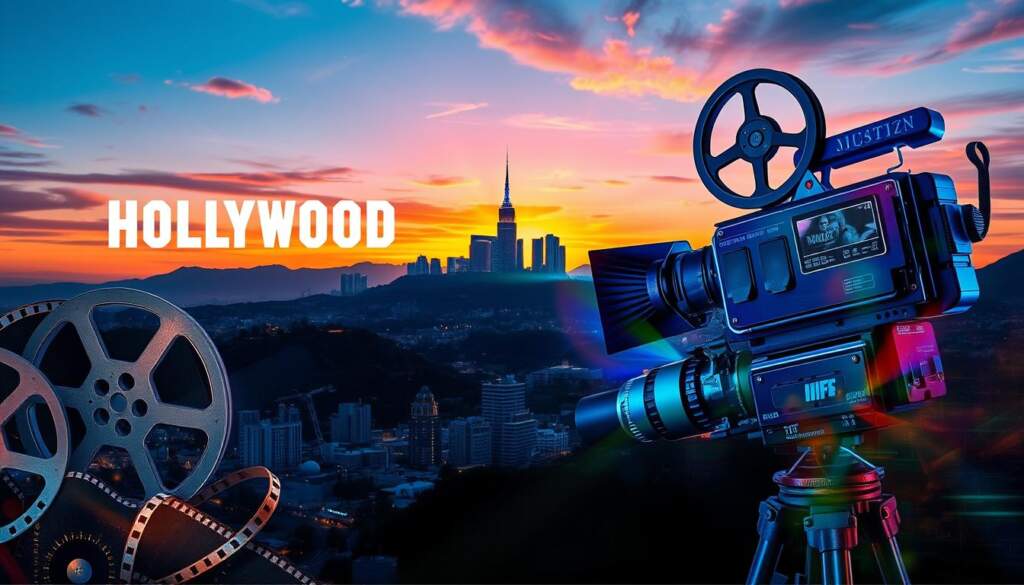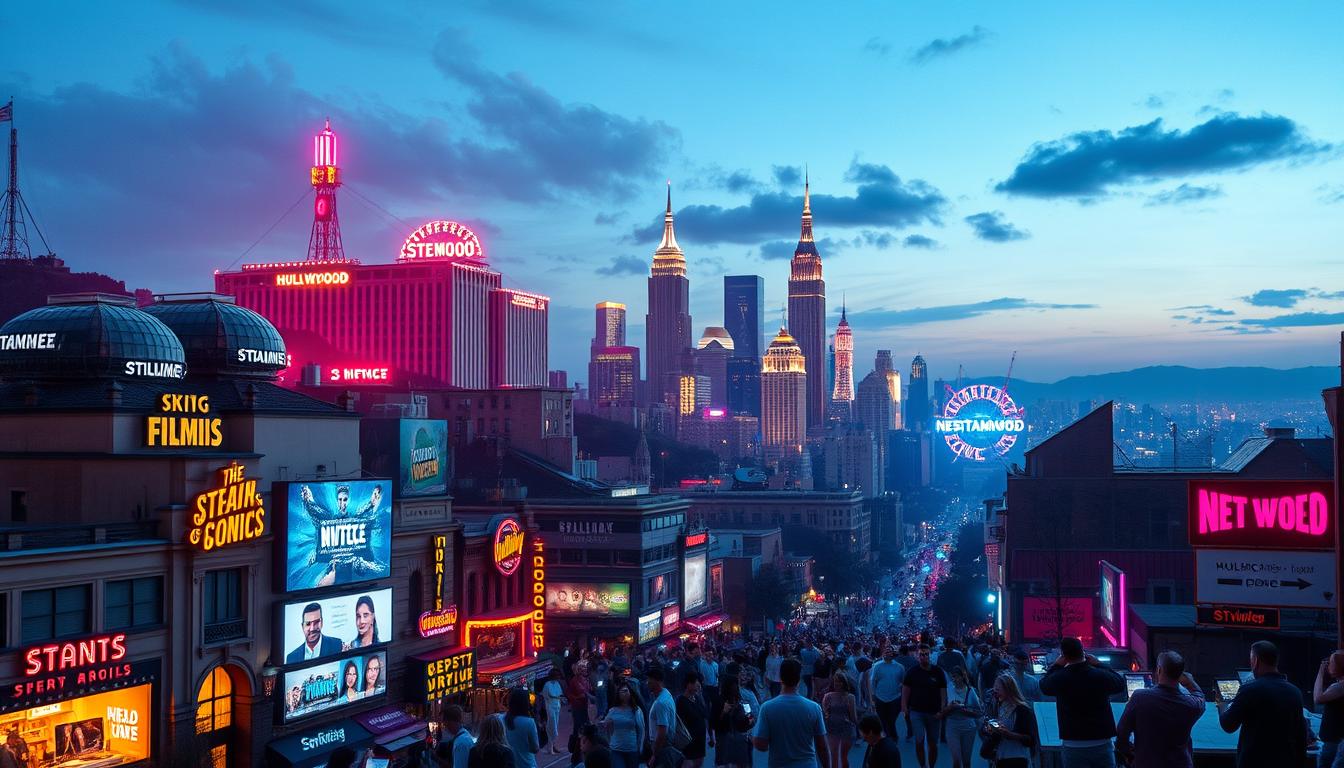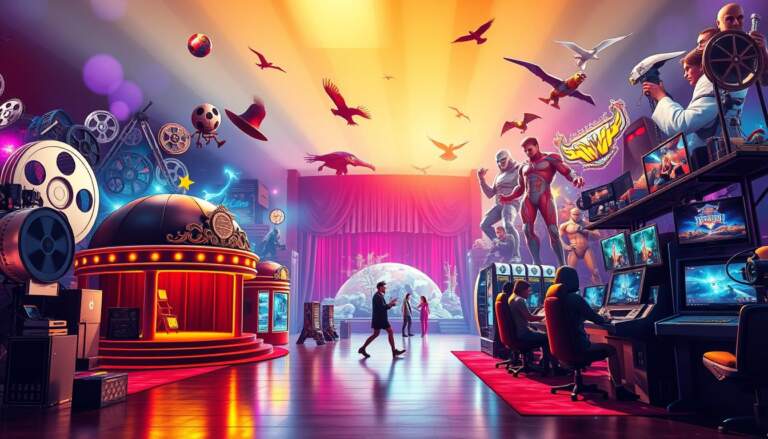The entertainment landscape has undergone a seismic shift as streaming services redefine the parameters of Hollywood transformation. Originally a space dominated by the palpable charm of theaters, the evolution of entertainment consumption has ushered in a new era where streaming vs theater is the crossroads of today’s film industry. The litmus test for this transformation emerged starkly as the preferences of audiences began changing, demonstrated by how the once standard 28% preference for movie theaters dwindled to 14% by 2020, while streaming took a bold leap from 15% to 36% during the same period1. This remarkable transition, fueled by the global health crisis, led to an alarming contraction in theater attendance, with platforms like Netflix diversifying their library to over 6,000 original titles, charting a course toward a fully original catalog by May 20271. Integrating these offerings at a more competitive price point of $6.99 compared to the traditional $10.45 movie ticket1, streaming giants are recalibrating the value proposition for consumers.
Key Takeaways
- The shift from traditional theater preference to streaming has become sharply evident between 2018 and 20201.
- Streaming giants like Netflix are substantially growing their slate of original content, eyeing complete original libraries in the near future1.
- Affordability of streaming services contributes to the Hollywood transformation, offering monthly subscriptions at a cost lower than a single movie ticket1.
- The rise of free streaming platforms and ad-supported tiers offers new models of revenue and audience capture amidst subscription fatigue2.
- Hollywood’s conventional players are facing the challenge of adapting to an industry progressively dominated by streaming services2.
The Evolution of Home Entertainment: From VHS to Streaming Giants
The journey through the evolution of home entertainment is an exhilarating saga of technology that continuously reshapes consumer preferences and the very fabric of the media landscape. What began with the magnetic appeal of VHS tapes has now ballooned into a colossal streaming-led industry, turning living rooms into personalized theaters.
A Brief History: VHS and DVD’s Disruption of Theater Dominance
The VHS impact on consumer entertainment began in the late 1970s, providing a new layer of convenience and privacy. As the DVD era took over, two decades later, it further solidified the home as a central entertainment hub. These formats significantly diminished the once unchallenged allure of movie theaters, offering audiences the freedom to choose what, when, and how they watched films.
The Role of YouTube in Pioneering Online Entertainment
When YouTube entered the scene in 2005, it not only leveraged the burgeoning capability of the internet but also marked the inception of online media power in entertainment. Acquired by Google for $1.65 billion in 2006, YouTube has revolutionized the content production and consumption landscape, becoming a lucrative venture for its parent company and a cultural phenomenon worldwide3.
Consumer Preferences Shift from Theaters to Streaming amid the Pandemic
The global pandemic accelerated the shift in consumer preferences, with theater vs streaming battles tipping significantly towards digital platforms. As noted by industry metrics, by 2017, one in every four households in the US had subscribed to Netflix, showcasing a dramatic pivot from traditional movie-going experiences4. This change is emblematic of the wider transition within the home entertainment evolution, underscoring the increased reliance on digital solutions for leisure and engagement.
| Year | Netflix Subscribers | Streaming Revenue Forecast |
|---|---|---|
| 1999 | 239,000 | Projected to surpass $100 billion by 2026 in U.S5. |
| 2003 | 1 million | |
| 2017 | 125 million4 |
The compelling narrative of the home entertainment evolution underscores a clear trend: an unstoppable march towards digital consumption—streamlined, diversified, and customized. This transition not only reflects in the DVD era success and the VHS impact but is also pushed forward by the innovative strides in online media platforms like YouTube and comprehensive streaming services like Netflix3.
How Streaming is Reshaping Film Production and Distribution
The landscape of film production and distribution has undergone a seismic shift, largely due to the influence of streaming services. These platforms have not only altered viewing habits but also revolutionized the entire process from creation to consumption. The infusion of streaming into everyday entertainment is reshaping industry norms and practices, benefiting especially indie creators and enhancing content diversity.
Favoring Diverse Content and Indie Creators Over Traditional Studios
Streaming platforms like Netflix and Amazon Prime are becoming increasingly known for their support of indie creators and diverse narratives, distinguishing them from traditional film studios. This support is evident in their business models, which prioritize a wide range of content to appeal to global audiences. Such platforms often provide indie filmmakers with the resources needed to bring their unique visions to life, thereby enriching the cultural tapestry available to viewers. This democratization of film production has led to a notable increase in content diversity, fostering a richer, more varied entertainment landscape that champions underrepresented voices6.
Elasticity in Creative Endeavors Due to Direct Distribution Channels
The collapse of traditional distribution models has given rise to more elastic creative endeavors. Filmmakers now have the unprecedented ability to bypass traditional gatekeepers and directly engage with their audiences through streaming platforms. This direct distribution channel not only accelerates the pace at which content can be released but also offers filmmakers more creative freedom6. Moreover, through subscription-based models, creators are assured of a steadier income stream, which can potentially lead to more bold and experimental projects7.
The Collapse of the Theatrical Window and the Ascent of Video-on-Demand
The traditional theatrical window is fast becoming a relic of the past, with the rapid ascent of video-on-demand dramatically altering how movies are released and monetized. The pandemic accelerated this shift, as global theater attendance saw a decline, while streaming platforms experienced a surge in subscriptions7. This shift not only reflects changing consumer preferences but also compels filmmakers to adapt to new realities of film viewership and monetization strategies. The integration of SVOD model financial structures brings new challenges and opportunities, subtly influencing everything from film budgets to project scopes7.
As streaming continues to carve new pathways for indie creators and champion content diversity, the film industry stands at a crossroads. It is compelled to continuously evolve and embrace new technologies while fostering an environment where diverse stories can flourish. This evolution is not just reshaping film production and distribution but is also setting the stage for a more inclusive and engaging entertainment future.
The Cultural Impact of Binge-Watching and On-Demand Media
As we delve deep into the cultural fabric shaped by binge-watching culture, it’s apparent how streaming services like Netflix and Amazon Prime have not only revolutionized entertainment consumption changes but also transformed viewer habits. Providing access to entire seasons at once, these platforms allow users to consume content at unprecedented rates, fostering a phenomenon where algorithmic recommendations influence cultural prevalence89.
This shift has significant impacts on traditional media experiences. The rise of platforms like Twitch, which turns gaming into a spectator sport, indicates a pivot towards more interactive forms of entertainment consumption where viewers aren’t just passive recipients but active participants8. Meanwhile, traditional broadcast television, once a creator of shared cultural experiences, finds its influence waning as communal viewing gives way to personalized media streams.


The dynamism of streaming services impact extends beyond mere content consumption to affect the very economics of entertainment. With the average household subscribing to multiple services, the phenomenon known as “subscription fatigue” becomes prevalent, leading to a critical evaluation of value versus content overload10. This has prompted some platforms to explore serialized releases, seeking to balance engagement with anticipation— a stark contrast to the binge-watching model8.
Further embracing technology’s prowess, platforms integrate AR and VR, pushing toward more immersive viewing experiences that might soon redefine the boundaries of on-demand media8. Concurrently, niche services cater to specific interests, such as Shudder for horror aficionados and Crunchyroll for anime enthusiasts, showcasing a fragmentation of traditional media consumption into more personalized experiences8.
| Streaming Service | Unique Offering | Viewing Model |
|---|---|---|
| Netflix | Extensive global content | Binge and Serialized |
| Disney+ | Family-oriented programming | Weekly Releases |
| Twitch | Live streaming interactive | Real-time viewing |
The transformation in entertainment consumption changes reflects a broader cultural shift facilitated by digital technology. As more viewers choose streaming over traditional cinema—a trend underscored by declining theater attendance—film production adapts to these new realms. Independent filmmaking finds a fertile ground on digital platforms, democratizing what was once an industry controlled by major studios9.
In a rapidly evolving landscape, understanding these shifts is critical. For more insights on how streaming is shaping the future of entertainment, explore the detailed analysis provided at this comprehensive guide.
Adaptation and Survival: Hollywood’s Response to Streaming Dominance
In the face of robust streaming service competition, the entertainment industry response has emerged as a fascinating evolution of strategies aimed at maintaining a competitive edge. This transformation is driven by major entities within the sector redefining their operational and strategic models.
Hollywood adaptation is clearly visible through the endeavors of giants like Disney and Warner Bros. Discovery, who are aggressively updating their technological foundations and recalibrating their business strategies to better align with the digital age. With a high level of market dominance indicated by the fact that 90% of television content is now produced by major corporations such as AT&T, Comcast, and Disney, these powerhouses are moving swiftly to solidify their stance amidst the growing popularity of streaming platforms11.
The streaming wars have ushered in an era where content distribution is not just about reaching audiences, but engaging them deeply and maintaining their loyalty through enhanced viewing experiences. Ad-supported models are becoming increasingly popular, evidenced by Netflix’s reporting of 40 million global monthly active users for its advertising tier12.
Moreover, streaming giants are not just competing with one another but are also dissecting successful models from platforms like YouTube. For instance, NBCUniversal’s Peacock has been curating content feeds to mimic the YouTube Shorts effect, enhancing its competitive strategy12.


To better understand the scale of these adaptations, here’s a comparative snapshot of market share and audience engagement:
| Platform | Viewership Share (%) | Ad Revenue (Billion $) |
|---|---|---|
| YouTube | 9.7 | 31.5 in 2023 |
| Disney (Cable + Streaming) | 11.4 | N/A |
| Netflix (Ad tier users) | N/A | N/A |
The data reveals a significant shift in how viewers are engaging with content across different platforms, with YouTube alone capturing a substantially large portion of market share compared to traditional TV since the COVID-19 pandemic1112.
As Hollywood continues to navigate the dynamic landscape of the streaming service competition, the industry’s ability to adapt will likely dictate the future trajectories of these entertainment giants. The ongoing evolution in the streaming space highlights a broader trend within the entertainment industry and underscores the importance of innovation in content distribution strategies.
Conclusion
The integration of streaming services has undeniably shifted the paradigm of Hollywood evolution, ushering in a new era of digital entertainment while compelling industry adaptation. The landscape in which audiences consume media has been transformed, marking a definitive turn towards digital platforms.
In 2018, 28% of consumers experienced their first encounter with movie theaters, while a smaller faction of 15% leaned towards streaming. Since then, the scales have tipped significantly, with the percentage strongly favoring theaters dwindling to 14% by mid-2020, contrasting starkly against the 36% preferring streaming formats13. This shift underscores the streaming service future as not just an alternative but as a primary choice for many.
The inevitable disruption brought by streaming has had severe financial repercussions for traditional cinemas, with the sector experiencing massive losses amounting to billions in 202013. Conversely, giants like Netflix have aggressively pivoted towards a dominantly original content strategy, with plans to upscale their in-house content to approximately 75% by the end of 202413.
The competition not only heats up for viewership but also provides a unique advantage for indie films seeking traction and audience engagement through these platforms13. Despite these opportunities, the per-view payment model of streaming services often presents challenges for independent filmmakers in covering their production costs13.
| Year | Consumer Preference for Theaters | Consumer Preference for Streaming |
|---|---|---|
| 2018 | 28% | 15% |
| 2020 | 14% | 36% |
The reverberations from this evolution extend beyond content consumption to also include industry practices. Hollywood has witnessed a reshaping of its employment structures, with instances like shortened employment terms in writer rooms, reflecting broader trends of uncertainty and transformation in the creative sectors14. The migration towards streaming services thereby not only shifts the frontiers of viewer engagement but also redefines the operational frameworks within the traditionally structured Hollywood studios.
As the future unfolds, both opportunities and challenges will mold the trajectory of Hollywood evolution. The industry’s resilience will depend heavily on its ability to navigate these new waters with innovation and strategic collaborations that bridge the old with the new.
The Emerging Role of Interactive and Ad-Supported Streaming
The streaming landscape is experiencing a significant transformation as services such as Netflix and Amazon Prime integrate ad-supported tiers into their subscription models. The introduction of these ad-supported options is a strategic move to diversify streaming revenue models and tap into the burgeoning realm of advertising strategies. In fact, with Netflix boasting 15 million monthly active users on its ad-supported plan and Disney+ reporting that half of its new subscribers opt for the ad-supported option, it is clear that these services are rapidly gaining traction among viewers1516. These ad plans are proving to be more than just an alternative; they are reshaping consumer behavior and expectations. At the forefront of this shift, nearly 60 percent of viewing hours on streaming platforms are attributed to ad-supported streaming, highlighting a major pivot in user engagement15.
Streaming companies are not only revamping their platforms with advertising but are also redefining the interactive streaming experience. During the recent football season, advertisers deploying interactive Streaming TV ads during “Thursday Night Football” witnessed an impressive 15% increase in detail page view rate compared to traditional, non-interactive formats16. This interactive component is indicative of the industry’s inclination towards innovative advertising solutions that aim to engage viewers in a more dynamic manner. Likewise, the streaming industry’s approach to monetization is undergoing a metamorphosis, as even Netflix, which accounts for a significant one-fifth of streaming time spent in the U.S., is starting to explore in-house ad platforms to increase its share of connected TV (CTV) ad revenues15.
The ascent of ad-supported services within the streaming domain is not only altering viewer preferences but is also impacting the financial framework of these platforms. Paramount+ and NBCUniversal, for instance, have adjusted their pricing models in light of the growth in ad-supported streaming, which is evolving the overall profitability dynamic of the industry17. Magna Global’s projection that ad-supported streaming will account for nearly 60 percent of the U.S. population by the end of 2024 is a testament to the model’s anticipated success and acceptance15. As such, a delicate balance must be struck to ensure that the pursuit of advertising profits does not come at the expense of viewer satisfaction, which remains higher on ad-free platforms. These developments mark a significant change in how streaming giants engage their audiences and monetize their content, ultimately signalling a renaissance in the digital entertainment space.
FAQ
How have streaming services affected the Hollywood landscape?
What were the pivotal moments in the evolution of home entertainment?
In what ways is streaming promoting content diversity and support for indie creators?
What is the cultural impact of binge-watching and the rise of on-demand media?
How is Hollywood adapting to compete with streaming service giants?
What does the future hold for streaming services and their relationship with advertising?
How has the pandemic affected the competition between streaming services and movie theaters?
Source Links
- Streaming Platforms and Their Impact on the Film Industry – https://blog.filmtrack.com/industry-insights/streaming-platforms-and-their-impact-on-the-film-industry
- Everyone’s watching free TV. That’s a big problem for Hollywood. – https://www.businessinsider.com/behind-free-tv-rise-big-problem-for-hollywood-2024-8
- How streaming started: YouTube, Netflix, and Hulu’s quick ascent – https://www.businessofbusiness.com/articles/a-brief-history-of-video-streaming-by-the-numbers/
- No title found – https://www.businessmodelsinc.com/en/inspiration/blogs/netflix-how-a-dvd-rental-company-changed-the-way-we-spend-our-free-time
- Streaming video revolution: Traditional media adapts to a digital shift – https://www.spglobal.com/market-intelligence/en/news-insights/research/streaming-video-revolution-traditional-media-adapts-to-a-digital-shift
- The Impact of Streaming Services on the Film Industry – Roster Con – https://www.rostercon.com/en/magazine/movies/the-impact-of-streaming-services-on-the-film-industry-382994
- The Impact of Streaming Services on the Movie Industry: Transforming Entertainment as We Know It – Social Cinema – https://motionpicture.edu/socialcinema/2023/06/19/the-impact-of-streaming-services-on-the-movie-industry/
- The Streaming Culture: How it Shapes the Present and Defines Our Future – https://www.linkedin.com/pulse/streaming-culture-how-shapes-present-defines-our-future-gzaxc
- What Is The Impact Of Streaming Platforms On Cinema? – https://www.usemogul.com/post/what-is-the-impact-of-streaming-platforms-on-cinema
- Beyond the Binge: Redefining Success in Streaming – https://www.iab.com/blog/beyond-the-binge-redefining-success-in-streaming/
- Hollywood survival strategies in the post-COVID 19 era – Humanities and Social Sciences Communications – https://www.nature.com/articles/s41599-021-00776-z
- YouTube dominates streaming, forcing media companies to decide whether it’s friend or foe – https://www.cnbc.com/2024/06/26/youtube-streaming-dominance-media-strategy.html
- Exploring the Impact of Streaming on the Film Industry – https://filmshortage.com/exploring-the-impact-of-streaming-on-the-film-industry/
- How streaming, mergers and other major changes are upending Hollywood – https://www.npr.org/2024/04/25/1246886718/how-streaming-mergers-and-other-major-changes-are-upending-hollywood
- It’s been a year since Netflix launched its ad tier. Here’s what advertisers can expect next. | The Current – https://www.thecurrent.com/netflix-advertising-streaming-amazon-media
- How the Ad-Supported Streaming Era Is Transforming the Ways Brands Reach Audiences – https://variety.com/2024/biz/news/how-ad-supported-streaming-era-transforming-ways-brands-reach-audiences-1235932272/
- Why Streaming Services Are Pushing Subscribers to Ad Tiers – https://www.hollywoodreporter.com/business/business-news/netflix-disney-now-pushing-subscribers-to-ad-tiers-1235572459/





